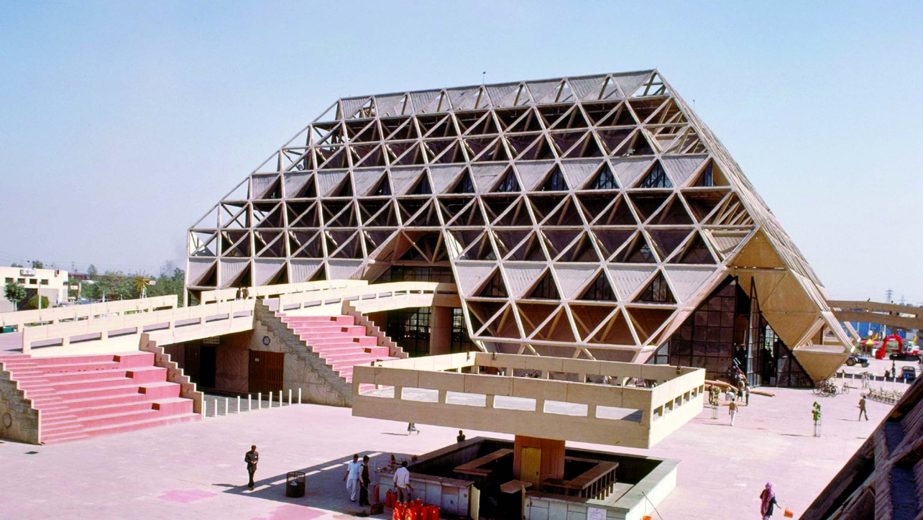
Weekend Plus Desk :
In all his projects, architect Raj Rewal revisits India’s architectural past as he shapes modern buildings. Indian Modernity – The Architecture of Raj Rewal is a film that documents his life since his early childhood in Punjab. Written, directed and produced by Manu Rewal, the 96-minute film is a linear narrative of Rewal’s career, with significant emphasis on buildings such as the Hall of Nations, Parliament Library Building, and National Institute of Immunology in Delhi; Visual Arts Institutional Campus, Rohtak; and Lisbon Ismaili Centre, Portugal, among others. Shown at a private screening at the Alliance Francaise de Delhi last week, for the first time, the film pairs scenes at these buildings with graphics of space construction, allowing viewers to map the way Rewal structures his programmes. Manu worked on the animation with technicians from the Centre Pompidou Paris, who have co-produced the film.
The film threads through Rewal’s design of the Hall of Nations, which in the early ’70s, was a symbol of technological advancement and scientific enquiry, and ends with the most-recent Rohtak Campus, which straddles imagery of Jaipur’s sundials and European universities. If the Hall of Nations brought in renewed vitality by its monumental triumph, the Campus wakes up to environment-conscious ideas of living. The film thematically divides Rewal’s work into sections such as rasa and structure; stone and courtyard; context and singularity; habitat; and sustainability.
Manu draws the audience to see Rewal’s design strategy of courtyards in public buildings, human scale streets in housing colonies, metaphors of memory and geometry, and the ubiquitous play of light and shadow. “I believe my father is a modern architect who takes the strains of tradition and uses what is relevant for today. For instance, his reaffirmation of courtyards and use of stone travel back to Indus Valley times, but he gives it a current context,” says Manu, who has been making films for over 25 years.
Through interviews with Delhi-based urban planner AGK Menon, well-known structural engineer and collaborator Mahendra Raj, A Lemonier, curator, Centre Pompidou and philosopher Ramin Jahanbegloo, Manu decodes Rewal’s contribution to India’s modern landscape. Together with contemporaries such as Ahmedabad-based BV Doshi, Mumbai-based Charles Correa and Delhi-based Achyut Kanvinde, they built India’s landscape post Independence.
Rewal, who returned to India in 1962 after architectural and artistic studies in London and Paris, arrived into the thick of collective consciousness.
“The Hall of Nations, for instance, presents the aesthetic and cultural values of India, which is a mix the old and the new. Rewal’s buildings are of vital importance at a time when the world needs inter-cultural dialogue,” says Jahanbegloo, who has authored Talking Architecture, a book on Rewal’s philosophy.
If one wonders where the users of the buildings are, Manu willingly acknowledges their absence. “I’ve observed that users tend to say things at a superficial level that they like or don’t like a building. I’ve attempted to give an in-depth analysis about the design and the architect’s intent in the film.” n
In all his projects, architect Raj Rewal revisits India’s architectural past as he shapes modern buildings. Indian Modernity – The Architecture of Raj Rewal is a film that documents his life since his early childhood in Punjab. Written, directed and produced by Manu Rewal, the 96-minute film is a linear narrative of Rewal’s career, with significant emphasis on buildings such as the Hall of Nations, Parliament Library Building, and National Institute of Immunology in Delhi; Visual Arts Institutional Campus, Rohtak; and Lisbon Ismaili Centre, Portugal, among others. Shown at a private screening at the Alliance Francaise de Delhi last week, for the first time, the film pairs scenes at these buildings with graphics of space construction, allowing viewers to map the way Rewal structures his programmes. Manu worked on the animation with technicians from the Centre Pompidou Paris, who have co-produced the film.
The film threads through Rewal’s design of the Hall of Nations, which in the early ’70s, was a symbol of technological advancement and scientific enquiry, and ends with the most-recent Rohtak Campus, which straddles imagery of Jaipur’s sundials and European universities. If the Hall of Nations brought in renewed vitality by its monumental triumph, the Campus wakes up to environment-conscious ideas of living. The film thematically divides Rewal’s work into sections such as rasa and structure; stone and courtyard; context and singularity; habitat; and sustainability.
Manu draws the audience to see Rewal’s design strategy of courtyards in public buildings, human scale streets in housing colonies, metaphors of memory and geometry, and the ubiquitous play of light and shadow. “I believe my father is a modern architect who takes the strains of tradition and uses what is relevant for today. For instance, his reaffirmation of courtyards and use of stone travel back to Indus Valley times, but he gives it a current context,” says Manu, who has been making films for over 25 years.
Through interviews with Delhi-based urban planner AGK Menon, well-known structural engineer and collaborator Mahendra Raj, A Lemonier, curator, Centre Pompidou and philosopher Ramin Jahanbegloo, Manu decodes Rewal’s contribution to India’s modern landscape. Together with contemporaries such as Ahmedabad-based BV Doshi, Mumbai-based Charles Correa and Delhi-based Achyut Kanvinde, they built India’s landscape post Independence.
Rewal, who returned to India in 1962 after architectural and artistic studies in London and Paris, arrived into the thick of collective consciousness.
“The Hall of Nations, for instance, presents the aesthetic and cultural values of India, which is a mix the old and the new. Rewal’s buildings are of vital importance at a time when the world needs inter-cultural dialogue,” says Jahanbegloo, who has authored Talking Architecture, a book on Rewal’s philosophy.
If one wonders where the users of the buildings are, Manu willingly acknowledges their absence. “I’ve observed that users tend to say things at a superficial level that they like or don’t like a building. I’ve attempted to give an in-depth analysis about the design and the architect’s intent in the film.” n

